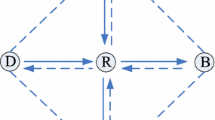Abstract
Network coding (NC) significantly increases communication opportunities and improves network performance. The focus of most research is on performance analysis with the same packet length of input flows. However, the length of packets is different in real networks and affects network coding performance. In this paper, first we proposed an asynchronous network coding strategy with periodic broadcasting at the relay node and simulated the relation between the broadcasting period and the coding gain. Second, we took the packet length into consideration and obtained the mathematical relation between the coding gain and the packet length for a given arrival rate. Finally, we verified the results via simulation. Our work showed that the impact of the packet length could not be ignored when using network coding. The methodology to improve the performance of NC in real networks is provided when the statistical length of packets is considered.









Similar content being viewed by others
References
Agiwal, M., Roy, A., & Saxena, N. (2016). Next generation 5G wireless networks: A comprehensive survey. IEEE Communications Surveys & Tutorials, 18(3), 1617–1655.
Torres Compta, P., Fitzek, F. H., & Lucani, D. E. (2015). Network coding is the 5G key enabling technology: Effects and strategies to manage heterogeneous packet lengths. Transactions on Emerging Telecommunications Technologies, 26(1), 46–55.
Yin, C., Dong, P., Du, X., Zheng, T., Zhang, H., & Guizani, M. (2020). An adaptive network coding scheme for multipath transmission in cellular-based vehicular networks. Sensors, 20(20), 5902.
Wang, L., Liu, Y., Xu, J., Yin, J., Xu, L., & Yang, Y. (2020). Network coding for reliable video distribution in multi-hop device-to-device communications. EURASIP Journal on Wireless Communications and Networking, 2020(1), 1–21.
Katti, S., Rahul, H., Hu, W., Katabi, D., Médard, M., & Crowcroft, J. (2008). Xors in the air: Practical wireless network coding. IEEE/ACM Transactions on Networking (ToN), 16(3), 497–510.
Médard, M., & Sprintson, A. (2011). Network coding: Fundamentals and applications. Cambridge: Academic Press.
Gruska, D. P. (2006). Network information flow. Fundamenta Informaticae, 72(1–3), 167–180.
Liu, C. H., & Xue, F. (2008). Network coding for two-way relaying: Rate region, sum rate and opportunistic scheduling. In 2008 IEEE international conference on communications (pp. 1044–1049). IEEE.
Moradian, M., Ashtiani, F., & Khonsari, A. (2020). Stability region and delay analysis of a SWIPT-based two-way relay network with opportunistic network coding. IEEE Transactions on Vehicular Technology, 69, 15682–15693.
Ma, Y., Li, W., Fan, P., Letaief, K. B., & Liu, X. (2009). On the characteristics of queueing and scheduling at encoding nodes for network coding. International Journal of Communication Systems, 22(6), 755–772.
Yuan, Y., Wu, K., Jia, W., & Peng, Y. (2012). On the queueing behavior of inter-flow asynchronous network coding. Computer Communications, 35(13), 1535–1548.
Alsebae, A., Leeson, M., & Green, R. (2014). Performance of a network coding queuing model with deterministic service. In 9th international symposium on communication systems, networks & digital sign (CSNDSP) (pp. 988–993). IEEE.
Wang, L., Li, Y., Pan, B., Wu, Q., Yin, J., & Xu, L. (2020). Network coding for efficient video multicast in device-to-device communications. Sensors, 20(8), 2254.
Mirrezaei, S. M., Dosaranian-Moghadam, M., & Yazdanpanahei, M. (2014). Effect of network coding and multi-packet reception on point-to-multi-point broadcast networks. Wireless Personal Communications, 79(3), 1859–1891.
Chi, K., Zhu, Yh., Jiang, X., & Tian, X. (2014). Practical throughput analysis for two-hop wireless network coding. Computer Networks, 60, 101–114.
Dong, W., Chen, C., Liu, X., He, Y., Liu, Y., Bu, J., & Xu, X. (2014). Dynamic packet length control in wireless sensor networks. IEEE Transactions on Wireless Communications, 13(3), 1172–1181.
Taghouti, M., Lucani, D. E., Pedersen, M. V., & Bouallegue, A. (2016). Random linear network coding for streams with unequally sized packets: Overhead reduction without zero-padded schemes. In 2016 23rd international conference on telecommunications (ICT) (pp. 1–6). IEEE.
Dong, W., Yu, J., & Zhang, P. (2014). Exploiting error estimating codes for packet length adaptation in low-power wireless networks. IEEE Transactions on Mobile Computing, 14(8), 1601–1614.
Huang, K., Liu, W., Li, Y., Savkin, A., & Vucetic, B. (2020). Wireless feedback control with variable packet length for industrial IoT. IEEE Wireless Communications Letters, 9(9), 1586–1590.
Hansen, J., Lucani, D. E., Krigslund, J., Médard, M., & Fitzek, F. H. (2015). Network coded software defined networking: Enabling 5G transmission and storage networks. IEEE Communications Magazine, 53(9), 100–107.
Do-Duy, T., & Vázquez-Castro, M. Á. (2020). Finite-length performance comparison of network codes using random vs pascal matrices. AEU-International Journal of Electronics and Communications, 114(153), 012.
Dosaranian-Moghadam, M., Mirrezaei, S. M., & Yazdanpanahei, M. (2019). New evolution in two-way relay networks based on physical layer network coding. Telecommunication Systems, 71(2), 181–190.
Ata, S. O., & Altunbas, I. (2016). Fixed-gain AF PLNC over cascaded Nakagami-m fading channels for vehicular communications. AEU-International Journal of Electronics and Communications, 70(4), 510–516.
CAIDA. Packet size distribution comparison between internet links 2008. Retrieved from, https://www.caida.org/research/traffic-analysis/pkt_size_distribution/graphs.xml.
Author information
Authors and Affiliations
Corresponding author
Additional information
Publisher's Note
Springer Nature remains neutral with regard to jurisdictional claims in published maps and institutional affiliations.
Rights and permissions
About this article
Cite this article
Mirrezaei, S.M. A Perspective on Network Coding Based on Packet Length. Wireless Pers Commun 120, 481–497 (2021). https://doi.org/10.1007/s11277-021-08469-1
Accepted:
Published:
Issue Date:
DOI: https://doi.org/10.1007/s11277-021-08469-1




